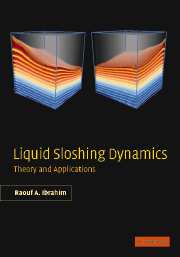Book contents
- Frontmatter
- Contents
- Foreword
- Acknowledgment
- Introduction
- Part I Linear sloshing dynamics
- Part II Nonlinear and parametric sloshing dynamics
- Part III Sloshing – structure interaction
- Part IV Rotating fluid and low gravity sloshing
- 11 Dynamics of rotating fluids
- 12 Microgravity sloshing dynamics
- References
- Index
11 - Dynamics of rotating fluids
from Part IV - Rotating fluid and low gravity sloshing
Published online by Cambridge University Press: 11 August 2009
- Frontmatter
- Contents
- Foreword
- Acknowledgment
- Introduction
- Part I Linear sloshing dynamics
- Part II Nonlinear and parametric sloshing dynamics
- Part III Sloshing – structure interaction
- Part IV Rotating fluid and low gravity sloshing
- 11 Dynamics of rotating fluids
- 12 Microgravity sloshing dynamics
- References
- Index
Summary
Introduction
The problem of fluid dynamic behavior in spinning tanks is encountered in the study of stability and control of rockets, space vehicles, liquid-cooled gas turbines, centrifuges, and oceans. Some spacecraft vehicles are designed to spin in order to gain gyroscopic stiffness during the transfer from low earth orbit. This spin helps to control liquid propellant location in its container. Another class of problems deals with the dynamics and stability of rotating rigid bodies as applied to the evolution of celestial bodies and astronavigation control. Stabilization is achieved when the spacecraft spins about its axis of minimum moment of inertia. A satellite that spins about its axis of minimum moment of inertia may experience instability in the presence of energy dissipation. This is similar to a spinning top on a rough surface and as a result of friction the top's nutation angle increases as it seeks to conserve angular momentum.
The theory of rotating fluids is well documented in Lamb (1945), Morgan (1951), Howard (1963), and Greenspan (1968). Usually, the fluid motion is characterized by certain types of boundary layers and dissipative behavior in addition to complicated viscous layers controlled processes for spin-up and spin-down (Wilde and Vanyo, 1993). Lighthill (1966) presented a survey on the dynamics of rotating fluid. The results always have to be distinguished by the magnitude of the ratio of spin speed and gravity, that is, by the parameter Ω2R/g, where Ω is the spin speed, R is the tank radius, and g is the gravitational acceleration.
- Type
- Chapter
- Information
- Liquid Sloshing DynamicsTheory and Applications, pp. 693 - 751Publisher: Cambridge University PressPrint publication year: 2005



